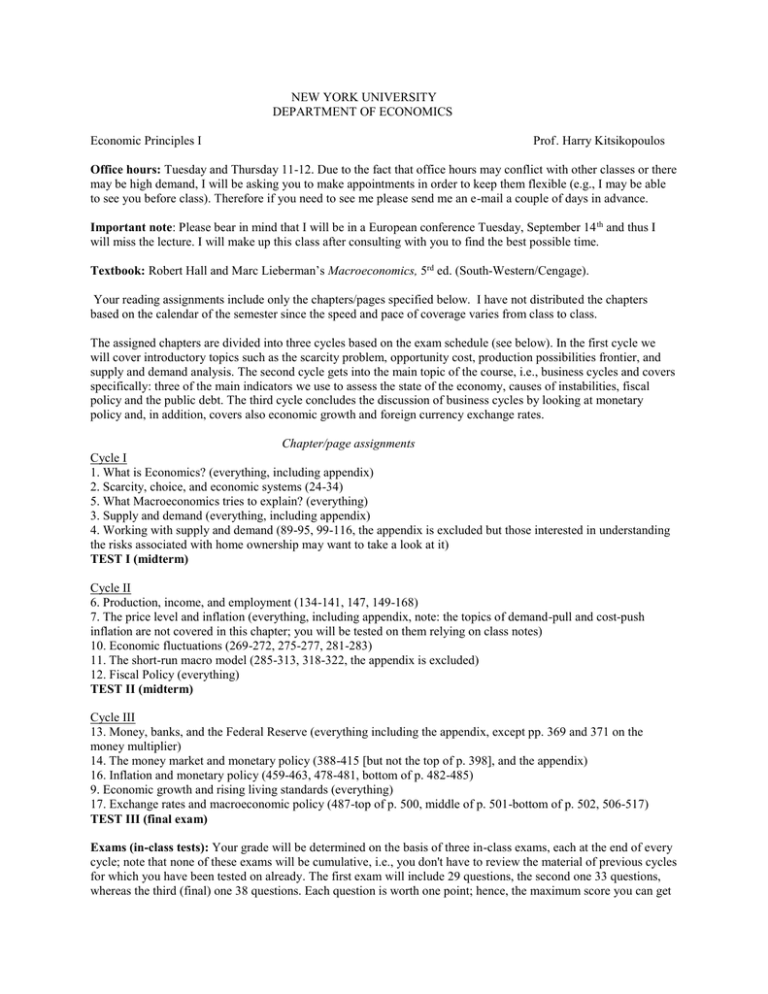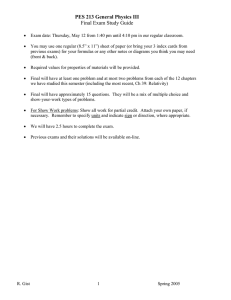NEW YORK UNIVERSITY DEPARTMENT OF ECONOMICS
advertisement

NEW YORK UNIVERSITY DEPARTMENT OF ECONOMICS Economic Principles I Prof. Harry Kitsikopoulos Office hours: Tuesday and Thursday 11-12. Due to the fact that office hours may conflict with other classes or there may be high demand, I will be asking you to make appointments in order to keep them flexible (e.g., I may be able to see you before class). Therefore if you need to see me please send me an e-mail a couple of days in advance. Important note: Please bear in mind that I will be in a European conference Tuesday, September 14 th and thus I will miss the lecture. I will make up this class after consulting with you to find the best possible time. Textbook: Robert Hall and Marc Lieberman’s Macroeconomics, 5rd ed. (South-Western/Cengage). Your reading assignments include only the chapters/pages specified below. I have not distributed the chapters based on the calendar of the semester since the speed and pace of coverage varies from class to class. The assigned chapters are divided into three cycles based on the exam schedule (see below). In the first cycle we will cover introductory topics such as the scarcity problem, opportunity cost, production possibilities frontier, and supply and demand analysis. The second cycle gets into the main topic of the course, i.e., business cycles and covers specifically: three of the main indicators we use to assess the state of the economy, causes of instabilities, fiscal policy and the public debt. The third cycle concludes the discussion of business cycles by looking at monetary policy and, in addition, covers also economic growth and foreign currency exchange rates. Chapter/page assignments Cycle I 1. What is Economics? (everything, including appendix) 2. Scarcity, choice, and economic systems (24-34) 5. What Macroeconomics tries to explain? (everything) 3. Supply and demand (everything, including appendix) 4. Working with supply and demand (89-95, 99-116, the appendix is excluded but those interested in understanding the risks associated with home ownership may want to take a look at it) TEST I (midterm) Cycle II 6. Production, income, and employment (134-141, 147, 149-168) 7. The price level and inflation (everything, including appendix, note: the topics of demand-pull and cost-push inflation are not covered in this chapter; you will be tested on them relying on class notes) 10. Economic fluctuations (269-272, 275-277, 281-283) 11. The short-run macro model (285-313, 318-322, the appendix is excluded) 12. Fiscal Policy (everything) TEST II (midterm) Cycle III 13. Money, banks, and the Federal Reserve (everything including the appendix, except pp. 369 and 371 on the money multiplier) 14. The money market and monetary policy (388-415 [but not the top of p. 398], and the appendix) 16. Inflation and monetary policy (459-463, 478-481, bottom of p. 482-485) 9. Economic growth and rising living standards (everything) 17. Exchange rates and macroeconomic policy (487-top of p. 500, middle of p. 501-bottom of p. 502, 506-517) TEST III (final exam) Exams (in-class tests): Your grade will be determined on the basis of three in-class exams, each at the end of every cycle; note that none of these exams will be cumulative, i.e., you don't have to review the material of previous cycles for which you have been tested on already. The first exam will include 29 questions, the second one 33 questions, whereas the third (final) one 38 questions. Each question is worth one point; hence, the maximum score you can get in the three exams is 29, 33, and 38 points respectively. Class participation is not one of your grade's determinants but is strongly encouraged. POLICIES REGARDING MISSED TESTS Missing a test is justified only in case of an emergency, such as a medical problem. In this case I would like to know your absence, ideally in advance, and you will have to produce some documentation. Bear in mind that I always check the authenticity of the latter. If a medical professional verifies the problem you will be entitled to a make-up. In the case of the final, however, if there are logistical issues in terms of giving you a make-up, it may have to be postponed until the final exams of the following semester in which case you will be getting an “Incomplete”. In the case of emergencies other than medical similar standards of proof will be applied. Please bear in mind that if your documentation is from the Health Center, it has to be signed by a physician or a nurse and state clearly that your illness (not need to be specific about it) was such that made your attendance to the exam unfeasible. Missing a test without documentation entails getting a zero for that test. Providing fake documents will entail the same penalty, plus a report to the Dean of Students for further action at the college level. You are also expected to show up before the class begins and to be quiet during the lecture. Grading policy: The perfect score in this course is 100 points. Your final grade will be based on the scale 100 A outlined in the left margin depending on your cumulative score in the three in-class 93.75 Aexams. If your cumulative score falls between two letter grades I will curve it to the next 87.50 B+ highest; for example, if your score is 88 points your grade will be A-. 81.25 B 75.00 B68.75 C+ 62.50 C 56.25 C50.00 D+ 43.75 D 37.50 F

